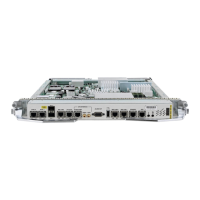control-plane based MAC learning in the core. In EVPN, PE's participating in the EVPN instances learn
customer MAC routes in Control-Plane using MP-BGP protocol. Control-plane MAC learning brings a number
of benefits that allow EVPN to address the VPLS shortcomings, including support for multi-homing with
per-flow load balancing.
The EVPN control-plane MAC learning has the following benefits:
• Eliminate flood and learn mechanism
• Fast-reroute, resiliency, and faster reconvergence when link to dual-homed server fails
• Enables load balancing of traffic to and from CEs that are multihomed to multiple PEs
The following EVPN modes are supported:
• Single homing - This enables you connect a customer edge (CE) device to one provider edge (PE) device.
• Multihoming - This enables you to connect a customer edge (CE) device to two or more provider edge
(PE) devices to provide redundant connectivity. The redundant PE device ensures that there is no traffic
disruption when there is a network failure. Following are the types of multihoming:
• Single-Active - In single-active mode, only a single PE among a group of PEs attached to the
particular Ethernet-Segment is allowed to forward traffic to and from that Ethernet Segment.
• Active-Active - In active-active mode, all the PEs attached to the particular Ethernet-Segment is allowed
to forward traffic to and from that Ethernet Segment.
EVPN Operation
At startup, PEs exchange EVPN routes in order to advertise the following:
• VPN membership: The PE discovers all remote PE members of a given EVI. In the case of a multicast
ingress replication model, this information is used to build the PE's flood list associated with an EVI.
• Ethernet segment reachability: In multi-home scenarios, the PE auto-discovers remote PE and their
corresponding redundancy mode (all-active or single-active). In case of segment failures, PEs withdraw
the routes used at this stage in order to trigger fast convergence by signaling a MAC mass withdrawal
on remote PEs.
• Redundancy Group membership: PEs connected to the same Ethernet segment (multi-homing)
automatically discover each other and elect a Designated Forwarder (DF) that is responsible for forwarding
Broadcast, Unknown unicast and Multicast (BUM) traffic for a given EVI.
L2VPN and Ethernet Services Configuration Guide for Cisco ASR 9000 Series Routers, IOS XR Release 6.3.x
486
EVPN Features
EVPN Operation

